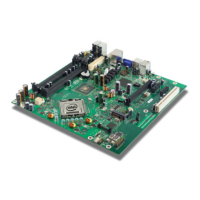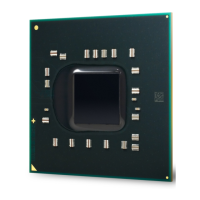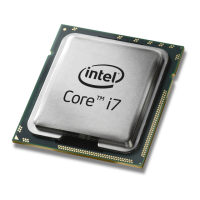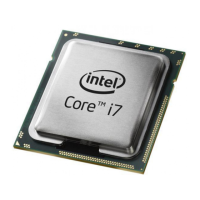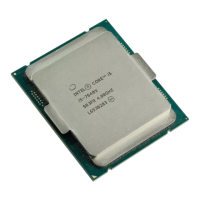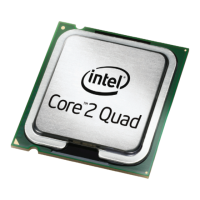10 Intel
®
Core
TM
Duo processor with the Mobile Intel
®
945GM Express Chipset
Development Kit User’s Manual
About This Manual
• The time difference between a signal at the input pin of a receiving
agent crossing the switching voltage (adjusted to meet the receiver
manufacturer’s conditions required for AC timing specifications;
i.e., ringback, etc.) and the output pin of the driving agent crossing
the switching voltage when the driver is driving a test load used to
specify the driver’s AC timings.
• Maximum and Minimum Flight Time - Flight time variations are
caused by many different parameters. The more obvious causes
include variation of the board dielectric constant, changes in load
condition, crosstalk, power noise, variation in termination
resistance, and differences in I/O buffer performance as a function
of temperature, voltage, and manufacturing process. Some less
obvious causes include effects of Simultaneous Switching Output
(SSO) and packaging effects.
• Maximum flight time is the largest acceptable flight time a network
will experience under all conditions.
• Minimum flight time is the smallest acceptable flight time a
network will experience under all conditions.
Infrared Data Assoc. The Infrared Data Association (IrDA) has outlined a specification for
serial communication between two devices via a bi-directional infrared
data port. The 945GM platform has such a port and it is located on the
rear of the platform between the two USB connectors.
IMVP6 The Intel Mobile Voltage Positioning specification for the Intel
®
Core™
Duo Processor. It is a DC-DC converter module that supplies the
required voltage and current to a single processor.
Inter-Symbol Interference
Inter-symbol interference is the effect of a previous signal (or transition)
on the interconnect delay. For example, when a signal is transmitted
down a line and the reflections due to the transition have not completely
dissipated, the following data transition launched onto the bus is
affected. ISI is dependent upon frequency, time delay of the line, and the
reflection coefficient at the driver and receiver. ISI may impact both
timing and signal integrity.
Media Expansion Card The Media Expansion Card (MEC) provides digital display options
through the SDVO interface. The MEC card also incorporates video-in.
Network The network is the trace of a Printed Circuit Board (PCB) that completes
an electrical connection between two or more components.
Overshoot The maximum voltage observed for a signal at the device pad, measured
with respect to VCC.
Pad The electrical contact point of a semiconductor die to the package
substrate. A pad is only observable in simulations.
Pin The contact point of a component package to the traces on a substrate,
such as the motherboard. Signal quality and timings may be measured at
the pin.
Power-Good “Power-Good,” “PWRGOOD,” or “CPUPWRGOOD” (an active high
signal) indicates that all of the system power supplies and clocks are
stable. PWRGOOD should go active a predetermined time after system

